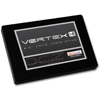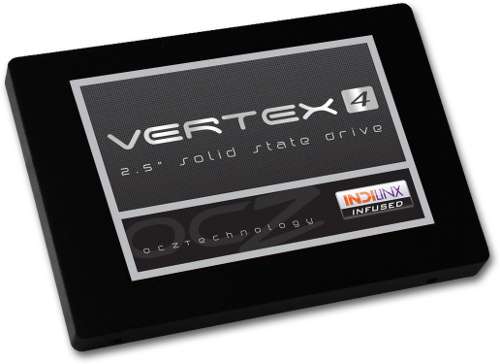- Qualcomm Launches Snapdragon 4 Gen 2 Mobile Platform
- AMD Launches Ryzen PRO 7000 Series Mobile & Desktop Platform
- Intel Launches Sleek Single-Slot Arc Pro A60 Workstation Graphics Card
- NVIDIA Announces Latest Ada Lovelace Additions: GeForce RTX 4060 Ti & RTX 4060
- Maxon Redshift With AMD Radeon GPU Rendering Support Now Available
OCZ Vertex 4 240GB SATA 6Gbit/s SSD Review

The Vertex is back, and this time it features more OCZ than ever before! (No, we’re not kidding.) Powered by its latest Everest 2 platform, the Vertex 4 is a completely in-house SSD that not only brings Indilinx back to the table, but very well has the potential to be the most reliable Vertex-branded SSD we’ve ever seen.
Page 9 – Final Thoughts
It should be noted that the launch firmware for the Vertex 4 was revision 1.3.X, and OCZ has since released the 1.4.1.3 update (the firmware utilized in our test sample). Amongst other things this version especially improves the Vertex 4’s performance at lower queue depths and may be worth considering updating to for the performance benefits.
However, a fair warning needs to be said, updating from a 1.3 firmware WILL destroy any data present on the V4. For safety we have always suggested updating the firmware on the SSD before installing to it, and if that is already impossible then make a full backup of the entire drive with a disk imaging program (such as Acronis) before updating the firmware. Also, never update the firmware on an SSD the computer is currently booted from.
With that out of the way, let’s dive into how the Vertex 4 has lived up to its heritage. To put it bluntly, OCZ’s Vertex 4 is simply astounding. Despite not utilizing any data compression trickery to give it an advantage, the Vertex 4 is able to either keep up with or exceed the performance of the Vertex 3 in the majority of our tests. Where the Vertex 3’s performance depends on the compressibility of the data in question, the Vertex 4 is data agnostic, or in other words, performance will not change regardless of the type of data passing through the controller.
That just leaves the big question about pricing. At current check the Vertex 4 slots in at $179 for the 128GB version and $239 for the 256GB model. Not only are these prices slightly less than its outgoing predecessor, but due to the difference in how the Everest 2 controller utilizes spare area, users will get a bonus 8GB (or 16GB) of usable capacity as well, if comparing to the older V3 drives. The pricing stacks up a little less favorably to the competition however, so the final decision will have to rest on other factors. One such factor is whether or not the consumer feels Everest 2 is a more stable, less buggy platform than all SF-2281 controllers still seem to suffer from, and if it is, then the price difference would easily be justifiable.

The Vertex 4 is the second SSD OCZ has been able to design from the start. The company began with a proven controller and modified it, launched it as the Everest 1, then in just a few months modified it again to remove discovered bottlenecks. It added a customized Indilinx firmware package and combined the ensemble with a custom PCB board design. But the important bit is since OCZ now owns Indilinx, this means it has a completely unparalleled level of access to the firmware package than it has had with any other SSD design until now. OCZ can now make any modifications or prioritizations it deems necessary in Indilinx’s firmware design that it sees fit. This will finally allow OCZ to maintain full control over the quality of its own solid-state drive brands and give it the ability to uniquely distinguish itself from its SandForce clone competitors.
Officially, it is too early to say with absolute certainty regarding the reliability question given how new Everest 2 still is, however given the quick shakedown run of Everest 1 on the Octane series and the proven reliability of the underlying hardware silicon platform, we feel that Everest 2 very well could finally be the stable, solid SSD that OCZ needs right now. Users that want to completely avoid the chance of mercurial BSoD problems, vanishing drives, or simply need working AES256 encryption may find the Vertex 4 to be the solid-state drive they’re looking for.
This naturally leads us into probably the best sign for the Vertex 4’s future, OCZ’s own confidence in its in-house SSD. OCZ Technology has launched the Vertex 4 with a full five-year warranty, which to date only a select few SSD manufacturers have been willing or able to do. SandForce-powered SSDs (with the single exception of the more expensive 520 Series) are notably absent from this select group. Even writing several gigabytes a day to the SSD every single day isn’t enough to wear out any 60GB or larger SSD within a five year period, so it is welcome to see the Vertex 4 lineup receiving that nice perk.
The V4 doesn’t yet have a proven track record, but it shows remarkable promise. OCZ’s Vertex 4 delivers SandForce-strong performance without the SandForce in a very well-balanced SSD offering. Read and write IOPS are both very strong and don’t sacrifice sequential performance to achieve it. Performance at higher queue depths is excellent, and SSD endurance is excellent as well thanks to Ndurance 2.0 – and OCZ isn’t afraid to prove it with a full 5 year warranty. With all this in mind the Vertex 4 should definitely be at the top of any SSD shortlist.

OCZ Vertex 4 SSD
Discuss this article in our forums!
Have a comment you wish to make on this article? Recommendations? Criticism? Feel free to head over to our related thread and put your words to our virtual paper! There is no requirement to register in order to respond to these threads, but it sure doesn’t hurt!
Support our efforts! With ad revenue at an all-time low for written websites, we're relying more than ever on reader support to help us continue putting so much effort into this type of content. You can support us by becoming a Patron, or by using our Amazon shopping affiliate links listed through our articles. Thanks for your support!




